The Essential Role of Medical-Grade Stainless Steel Storage
Stainless steel medical cabinets are purpose-built storage solutions designed specifically for healthcare environments where cleanliness, durability, and infection control are paramount. Here's what you need to know:
| Feature | Benefit |
|---|---|
| Material | 304 or 316 grade stainless steel resistant to corrosion and cleaning chemicals |
| Primary Uses | Operating rooms, sterile cores, laboratories, pharmacies, and morgues |
| Infection Control | Non-absorbent surfaces prevent bacterial growth and allow thorough disinfection |
| Durability | Typically include lifetime workmanship warranties; withstand decades of use |
| Configuration Options | Wall-mounted, freestanding, base, tall, with glass or solid doors |
Stainless steel medical cabinets serve as the backbone of organized healthcare storage, providing critical protection against Hospital Acquired Infections (HAIs) while maintaining the visibility and accessibility that busy medical professionals require. Unlike standard cabinetry, these specialized units are constructed from high-grade stainless steel (typically 304 or 316 grade) that can withstand harsh disinfectants, frequent cleaning, and decades of daily use.
The non-porous nature of stainless steel makes it uniquely suited for environments where contamination control is essential. With options ranging from fully-welded seams to tempered glass doors, these cabinets can be customized to meet the specific needs of any medical facility while maintaining compliance with stringent healthcare regulations.
I'm Mortuary Cooler, a national supplier of mortuary refrigeration systems with extensive experience integrating stainless steel medical cabinets into funeral homes and healthcare facilities across the country. My expertise includes helping facilities select the appropriate grade and configuration of stainless cabinetry to maximize both functionality and infection control.
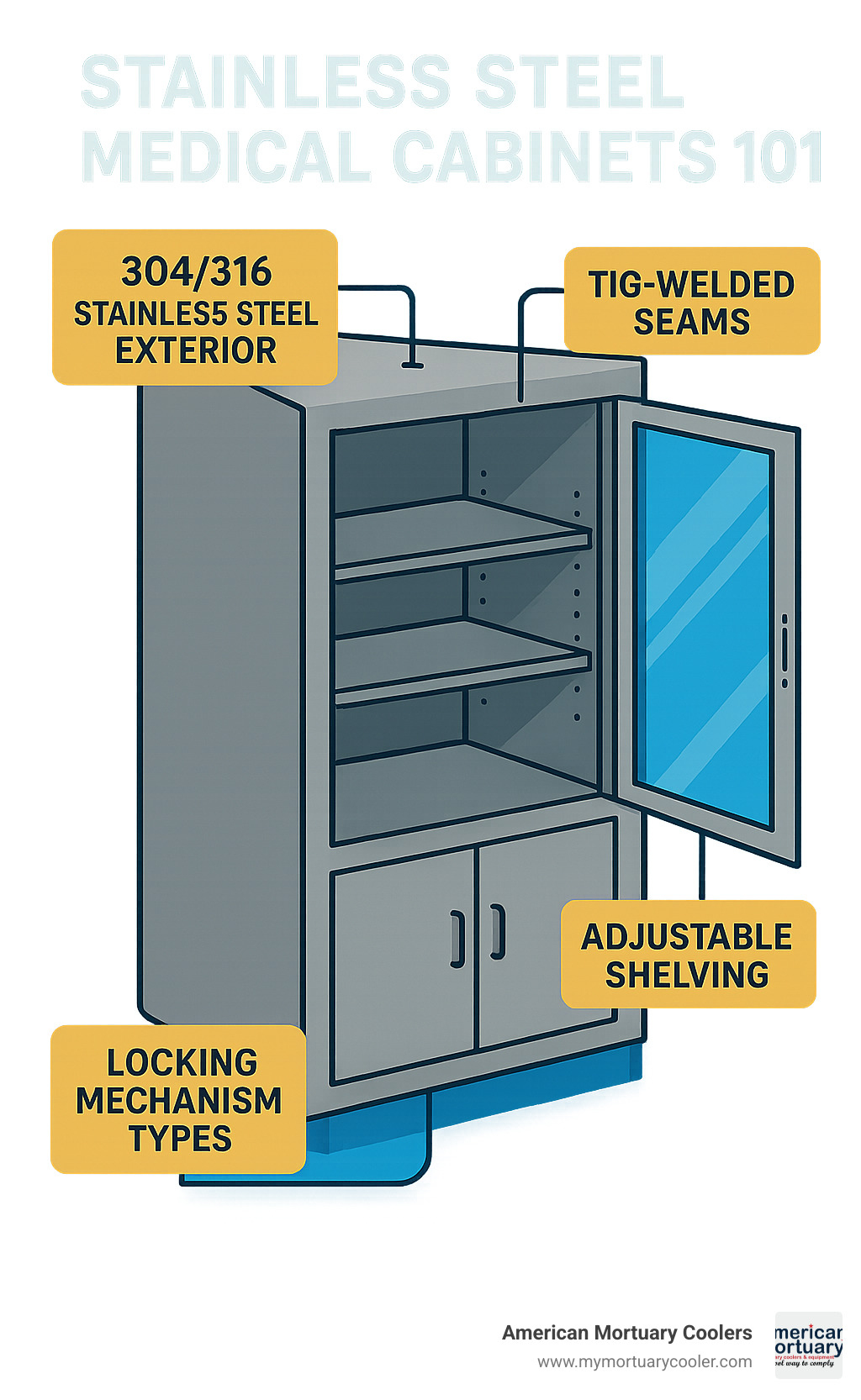
Basic stainless steel medical cabinets glossary:
Read This First
This comprehensive guide is designed for healthcare facility managers, hospital administrators, laboratory directors, funeral home operators, and anyone responsible for selecting medical-grade storage solutions. Whether you're outfitting a new facility or upgrading existing storage systems, understanding the nuances of stainless steel medical cabinets will help you make informed decisions that impact both operational efficiency and infection control.
In the following sections, we'll explore everything from material grades and construction techniques to customization options and compliance considerations. You'll learn how to evaluate suppliers, budget effectively, and select the right configuration for your specific needs.
Quick benefits snapshot:
- Exceptional durability (20+ year lifecycle)
- Superior infection control capabilities
- Customizable to fit any medical environment
- Compliance with healthcare regulations
- Long-term cost savings despite higher initial investment
Stainless Steel Medical Cabinets Explained
Ever walked into an operating room and noticed those gleaming metal cabinets lining the walls? Those aren't just any storage units. Stainless steel medical cabinets are the unsung heroes of healthcare environments, designed specifically to meet the demanding needs of medical settings where cleanliness isn't just preferred—it's absolutely essential.
Unlike the cabinets in your kitchen, these specialized units feature non-porous surfaces and seamless construction that leave nowhere for germs to hide. They're built to withstand the rigorous cleaning protocols that keep patients safe and facilities compliant.
You'll find these cabinets working hard across virtually every corner of modern healthcare:
In busy operating rooms, they keep sterile instruments and supplies dust-free and ready for use. Walk into any pharmacy and you'll spot them securing medications, often with special lockboxes for controlled substances. Laboratories rely on their chemical-resistant properties to safely store everything from delicate reagents to biological specimens. Sterile cores benefit from models with glass doors that allow staff to quickly locate supplies without unnecessary openings. Even in morgues and funeral homes, these cabinets provide sanitizable storage that stands up to harsh disinfectants.
At American Mortuary Coolers, we've seen how the right stainless steel medical cabinets can completely transform preparation rooms in funeral homes, creating spaces that are both functional and infection-resistant.
What Makes Stainless Steel Medical Cabinets Different?
The magic of stainless steel medical cabinets comes down to three key features that set them miles apart from standard cabinetry:
First, there's the 304/316 alloy composition. This isn't your everyday metal—it's a specialized blend containing precise amounts of chromium and nickel that creates an invisible protective layer on the surface. This microscopic shield fights corrosion and stands strong against chemicals, heat, and moisture day after day, year after year.
Then there's the welding technique. Full TIG welds create completely smooth seams that eliminate any tiny crevices where bacteria could set up camp. Unlike cheaper construction methods, these full seam welds create truly seamless surfaces that can be thoroughly disinfected from top to bottom.
Finally, that signature brushed #4 finish isn't just about looks. This satin appearance cleverly hides minor scratches while remaining incredibly easy to clean. For environments with even stricter requirements, electropolished finishes take cleanliness to the next level.
As one infection control specialist told me, "Once you've used stainless steel casework, you can't imagine going back to anything else. The peace of mind alone is worth the investment."
Core Uses Across the Facility
The versatility of stainless steel medical cabinets makes them indispensable throughout healthcare settings:
When surgical teams need instruments quickly, wall-mounted cabinets with glass doors allow them to locate what they need at a glance, minimizing door openings that could compromise sterility. For labs handling caustic chemicals, 316-grade stainless cabinets provide safe storage that won't degrade even after years of exposure to harsh substances.
Pharmacies appreciate cabinets with specialized narcotic lockboxes that satisfy DEA requirements while keeping other medications organized and visible. Laboratory professionals rely on these durable units to maintain specimen security in high-traffic environments where temperature control and cleanliness are non-negotiable.
In our work with funeral homes at American Mortuary Coolers, we've helped many clients integrate stainless steel medical cabinets into their preparation rooms. These spaces present unique challenges—they need the sterility of a medical environment combined with the durability to withstand powerful chemicals. The right stainless cabinet solutions serve both purposes beautifully, often becoming the backbone of an efficient, sanitary workspace.
Key Advantages & Infection-Control Benefits
When healthcare professionals choose stainless steel medical cabinets, they're investing in more than just storage—they're creating a foundation for better infection control. This isn't just marketing talk; it's the practical reality we've seen across hundreds of installations.
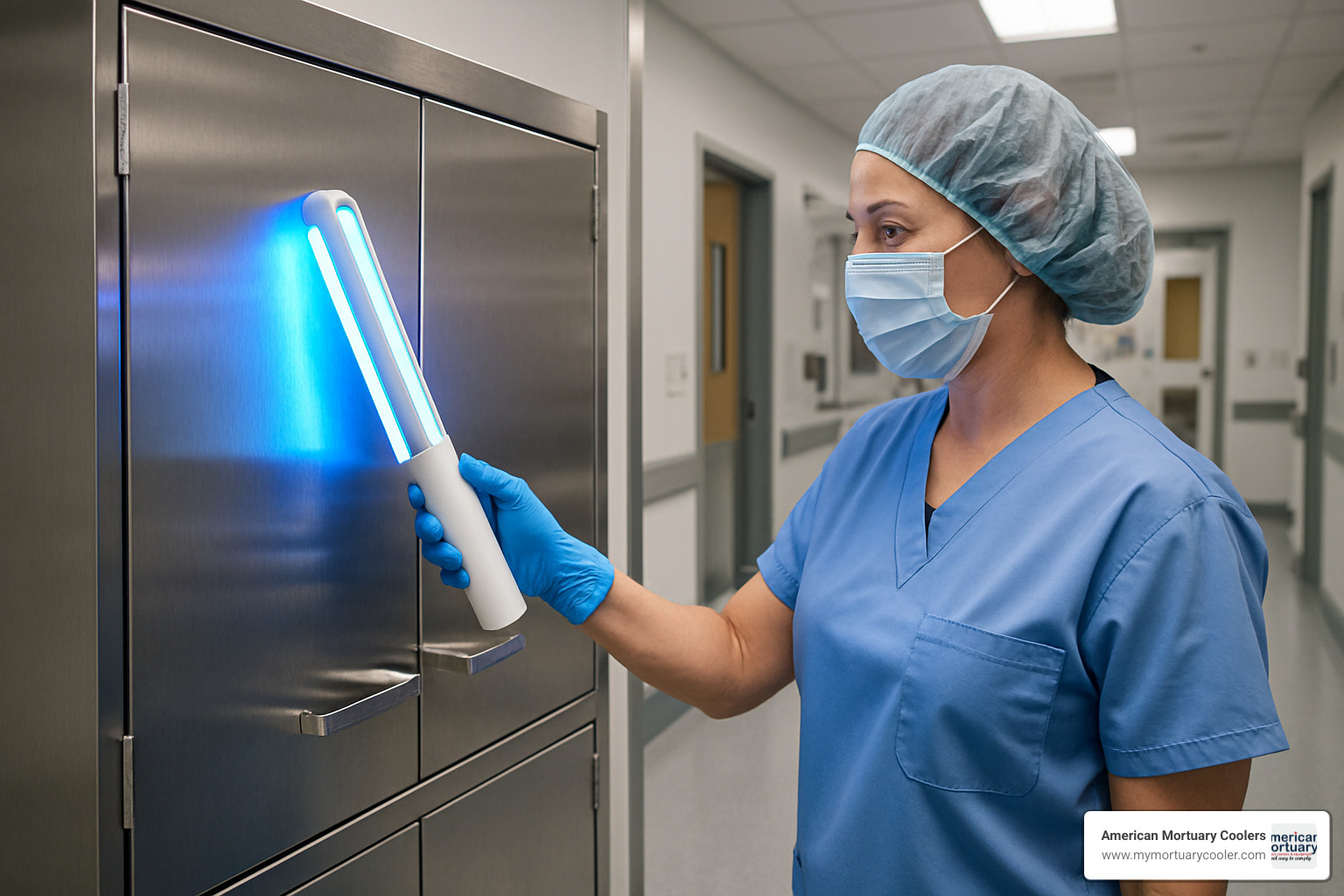
The smooth, non-porous surfaces of these cabinets make cleaning a breeze—just a quick wipe with hospital-grade disinfectants and you're done. What's even better is that unlike other materials, stainless steel medical cabinets don't degrade when exposed to those harsh chemicals day after day, year after year. This remarkable corrosion resistance means you won't be replacing them anytime soon.
We've had customers tell us how their cabinets have contributed to noticeable reductions in Hospital Acquired Infections (HAIs). It makes perfect sense—bacteria simply have fewer places to hide when surfaces are seamless and non-porous. For facilities focused on patient safety metrics, this advantage alone often justifies the investment.
Speaking of investment, the long lifecycle of these cabinets is impressive. While the initial cost might be higher than alternatives, the typical 20+ year lifespan in even the most demanding environments means the long-term value is exceptional. We've visited funeral homes still using the same stainless steel medical cabinets we installed two decades ago—and they look almost new with proper care.
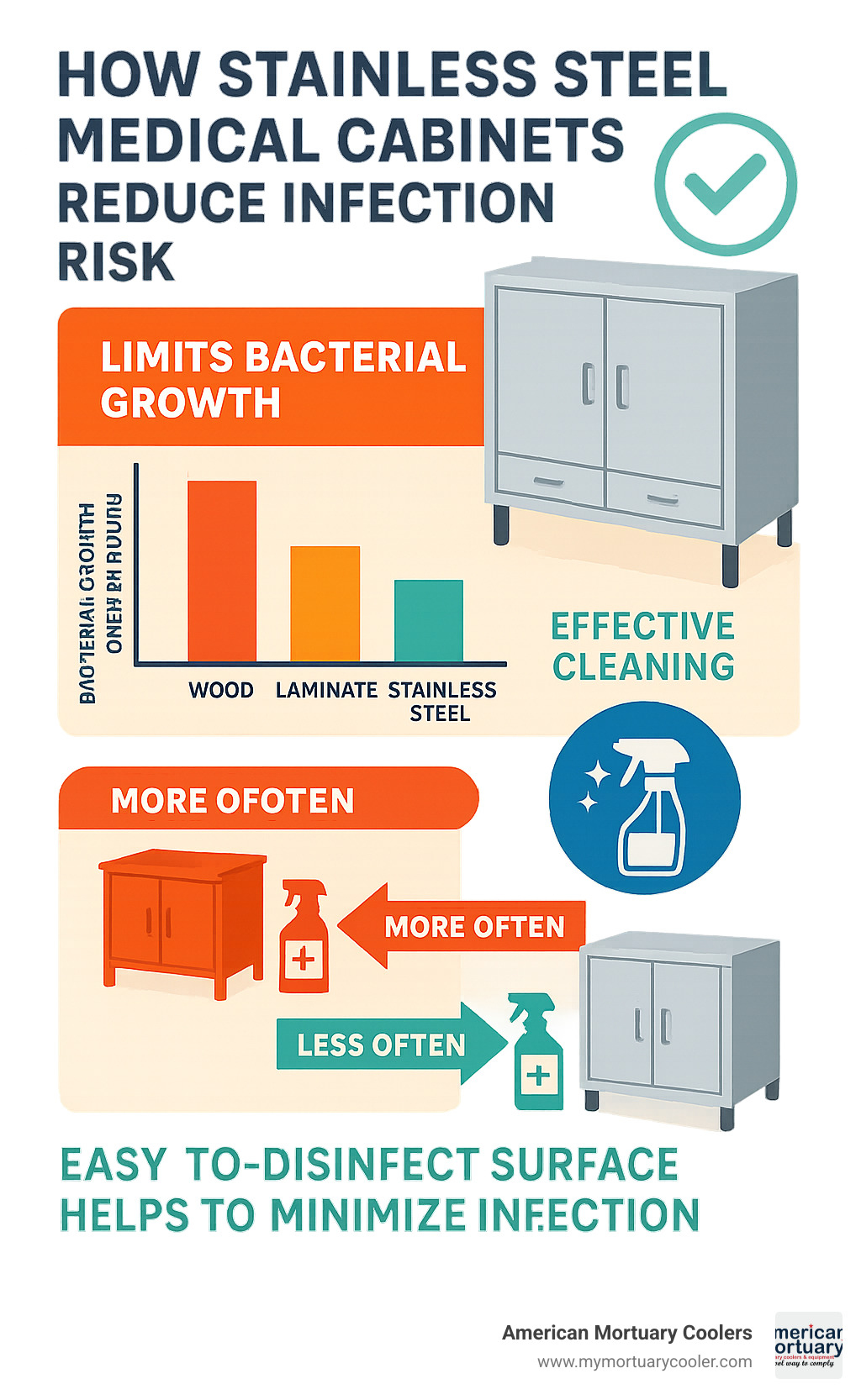
Want to learn more about comprehensive storage solutions for healthcare environments? Check out these healthcare storage products for complementary options.
How Stainless Steel Medical Cabinets Improve Hygiene
The hygiene benefits of stainless steel medical cabinets aren't just theoretical—they're built into the very structure of these units. Unlike wood or laminate that can absorb liquids (and the bacteria that come with them), stainless steel remains non-absorbent even after years of use.
Those beautiful seamless corners aren't just for looks. The TIG-welded construction eliminates the nooks and crannies where bacteria love to hide. This continuous surface means your cleaning staff can thoroughly disinfect every square inch—no special tools or techniques required.
I remember visiting a funeral preparation room that had switched from traditional cabinetry to our stainless steel medical cabinets. The director laughed and said, "Cleaning used to be a half-day job. Now we're done in under an hour, and I actually believe the room is truly clean."
Another overlooked advantage is the material's high-temperature tolerance. When a particularly thorough disinfection is needed, stainless steel can handle heat levels that would warp or damage other materials. This gives facilities more options for sanitization methods, especially important during disease outbreaks.
Compliance with Joint Commission & USP <797>
Let's face it—healthcare regulations aren't getting any simpler. Fortunately, stainless steel medical cabinets help facilities stay compliant without constant worry.
For Joint Commission inspections, these cabinets tick all the right boxes for Environment of Care (EC) standards. Their non-porous, easily cleanable surfaces make documentation of infection control protocols straightforward. When inspectors see stainless steel, they immediately recognize a facility's commitment to best practices.
Pharmacies compounding sterile preparations under USP <797> guidelines particularly benefit from stainless steel's non-shedding surface. Unlike particleboard or laminate that can degrade and release particles over time, stainless steel medical cabinets maintain their integrity in these sensitive environments.
Many of our customers appreciate that manufacturers provide validation records certifying their cabinets meet healthcare standards. This documentation makes compliance verification simple during inspections or audits. The standardized wipe-down protocols these cabinets support also help facilities maintain consistent cleaning practices—another regulatory requirement that becomes easier to fulfill.
While stainless steel itself doesn't contain antimicrobial properties (and be wary of manufacturers claiming otherwise!), its non-porous nature provides the perfect foundation for your facility's antimicrobial cleaning regimen. This combination delivers real-world protection against pathogens.
At American Mortuary Coolers, we've guided countless funeral homes through the process of updating their preparation rooms to meet evolving health standards. Time and again, stainless steel medical cabinets prove to be a future-proof investment that continues to meet standards as they evolve.
Types, Configurations & Custom Features
The world of stainless steel medical cabinets offers something for every healthcare space - whether you're outfitting a compact exam room or a spacious laboratory. What I love about these cabinets is their incredible versatility!
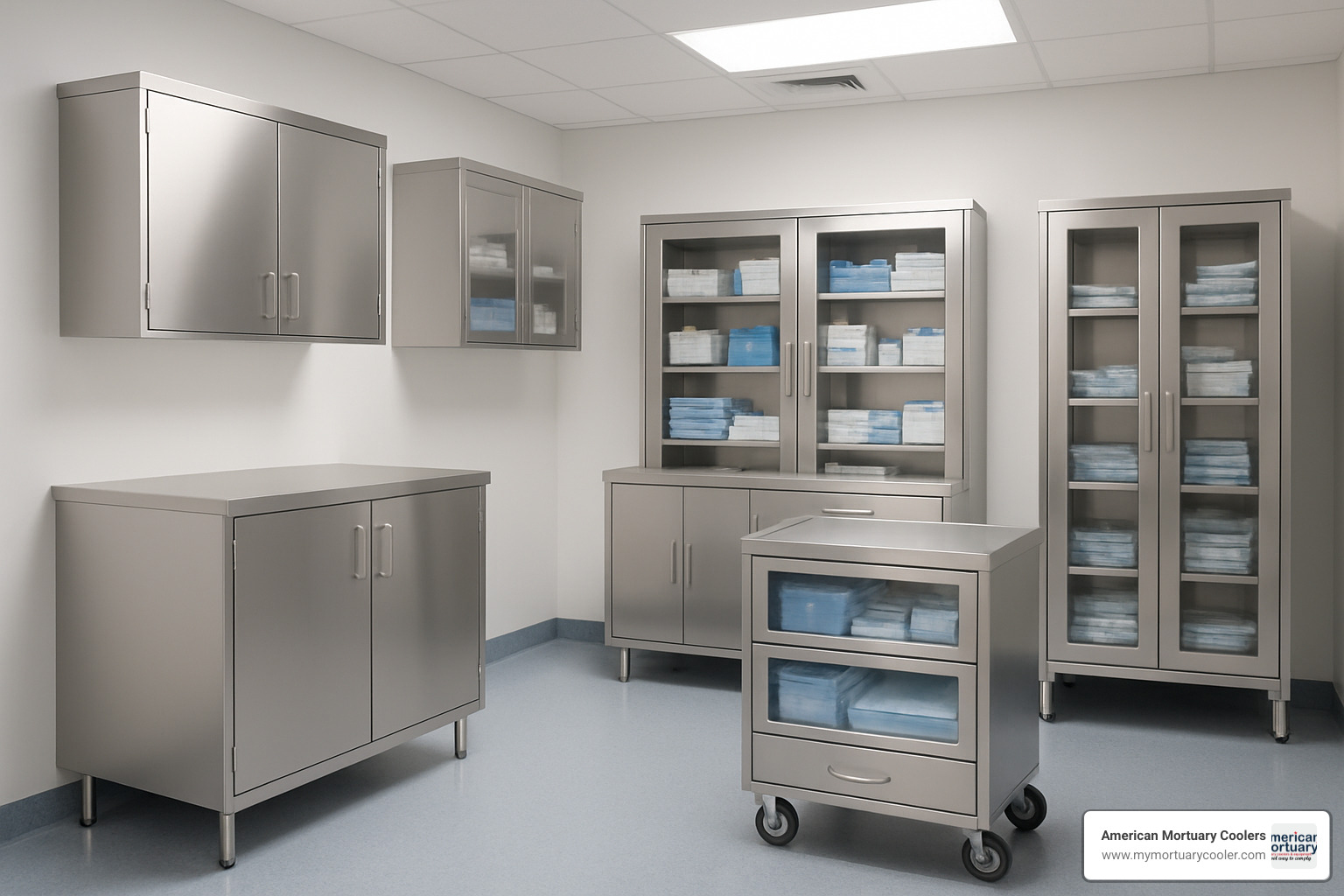
You'll find wall-mounted options that keep supplies liftd and floors clear for easy cleaning - perfect for tight spaces. If storage is what you need, freestanding tall cabinets (typically 1800-2100mm high) maximize your vertical space. For workstations, base cabinets sit at a comfortable counter height (around 900mm) and can support various work surfaces.
Working with an awkward space? Recessed cabinets built into wall cavities save precious floor space while providing generous storage. And when flexibility matters, mobile cabinets on casters let you bring supplies exactly where you need them.
Door options include solid stainless steel for maximum security, tempered glass for easy visibility, or clever combinations of both. In tight corridors, sliding doors eliminate swing clearance issues, while traditional hinged doors provide full access when space allows.
Popular Door Styles & Visibility Boosts
Let's talk about doors - they're not just about opening and closing! The right door style transforms how your team works with these cabinets every day.
Tempered glass doors are my personal favorite for busy healthcare environments. They let staff quickly spot what they need without opening multiple cabinets - something that saves time and reduces unnecessary touching (a big win for infection control). As one hospital manager told me, "Our nurses can locate supplies in seconds rather than opening every cabinet on the wall."
For maximum access, double-hinged doors open wide to reveal the entire cabinet interior - ideal when staff need to access multiple items at once during procedures. In narrow hallways or small treatment rooms, sliding panels glide smoothly without requiring clearance space.
At American Mortuary Coolers, we've noticed funeral homes particularly appreciate glass-doored cabinets in preparation rooms. They allow staff to locate instruments with just a glance - improving workflow and reducing unnecessary handling of supplies.
Security Add-Ons & Narcotic Lockers
When it comes to securing medications and controlled substances, stainless steel medical cabinets offer peace of mind with several security options.
Traditional keyed locks provide reliable security with restricted key access, while modern electronic keypads eliminate the hassle of physical keys and allow for code changes when staff turnover occurs. For highest-security applications, some facilities opt for advanced biometric systems that ensure only authorized personnel gain access.
Many pharmacies and clinical areas benefit from dedicated narcotic lockers - separately locked compartments built right into larger cabinets. These specialized sections help facilities meet DEA requirements for controlled substance storage while maintaining the infection control benefits of stainless construction.
One hospital pharmacy director shared: "Having the narcotic storage integrated with our other medication cabinets streamlined our workflow while meeting all our compliance requirements."
For funeral homes and medical examiner facilities working with controlled substances, these security features provide essential protection. At American Mortuary Coolers, we always discuss security needs when planning comprehensive storage solutions for our clients.
Customization & Modular Casework Options
Today's stainless steel medical cabinets aren't just standalone pieces - they're often part of thoughtfully designed modular systems that grow with your facility.
The beauty of modular casework is its adaptability. Using standardized components that work together in various configurations, these systems can be reconfigured as your needs change. This future-proofing approach saves money long-term, as you won't need to replace entire cabinet systems when workflows evolve.
For facility planners, many manufacturers now offer BIM/Revit families - digital design assets that make it easier to visualize and plan installations before a single cabinet is ordered.
The customization possibilities are nearly endless: adjustable shelving in ½" increments lets you optimize storage space; sloped tops prevent dust accumulation in critical environments; removable back panels provide access to wall utilities; and many systems can integrate service fixtures like sinks and electrical outlets.
At American Mortuary Coolers, we take pride in creating custom stainless steel medical cabinets that work harmoniously with other mortuary equipment. Rather than offering one-size-fits-all solutions, we listen to each client's specific needs and design storage systems that make their daily work more efficient. For more specialized options for funeral facilities, check out our More info about morgue refrigeration options.
The right cabinet configuration doesn't just store your supplies - it transforms how your team works every day.
Specifications: Steel Grades, Sizes & Load Capacities
Shopping for stainless steel medical cabinets can feel overwhelming with all the technical details. Let me break it down for you in plain English – because choosing the right cabinet shouldn't require an engineering degree!
Most quality cabinets use 18-gauge (1.2mm) stainless steel for the main body. That's about the thickness of a quarter – sturdy enough for daily use but not so heavy it requires a forklift to install! For the frames and bases that bear more weight, manufacturers typically use 16-gauge (1.5mm) steel, giving you that perfect balance of strength without turning your cabinet into a tank.
Here's what you'll typically find when browsing dimensions:
| Specification | Common Options | What That Means For You |
|---|---|---|
| Steel Gauge | 16-18 gauge | Lower numbers mean thicker steel (like golf scores!) |
| Height | 900mm, 1200mm, 1800mm, 2100mm | From counter-height to "can't reach the top shelf" tall |
| Width | 400mm (455mm overall), 600mm (655mm overall) | The first number is usable space, second includes the frame |
| Depth | 300mm, 400mm, 500mm, 600mm | Shallow for walls, deeper for base units |
| Weight Capacity | 500-2500 lbs | From "holds medical supplies" to "could support a small car" |
304 vs 316: Which Grade Fits Your Space?
The steel grade debate comes down to this: do you need good or great corrosion resistance? Both are excellent, but there are important differences:
304 Stainless Steel is the workhorse of the medical cabinet world. With 18% chromium and 8% nickel, it handles most healthcare environments beautifully. It's like buying a reliable sedan – it'll get you where you need to go without breaking the bank. We recommend 304 for most funeral homes and standard healthcare settings where normal cleaning protocols are followed.
316 Stainless Steel is the premium option, containing 16% chromium, 10% nickel, and the secret ingredient – 2% molybdenum (try saying that five times fast!). This addition makes it significantly more resistant to chlorides and harsh chemicals. It's about 20-30% more expensive, but worth considering if you're:
- Near the coast (salt air is surprisingly corrosive)
- Using particularly aggressive disinfectants
- Looking for the longest possible lifespan
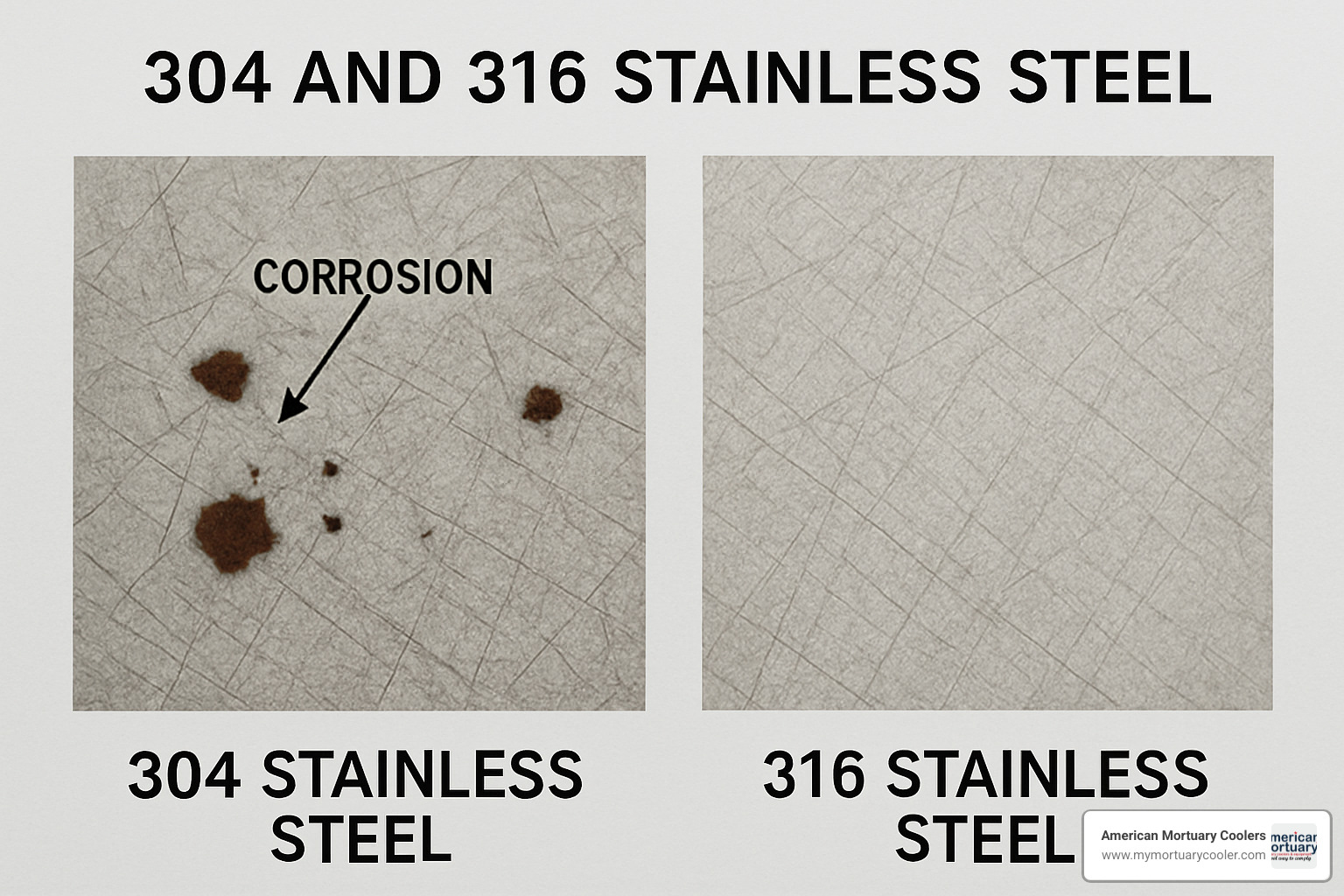
At American Mortuary Coolers, we've installed cabinets in every environment imaginable. Our experience shows that 304 stainless works perfectly for most funeral homes in standard environments. We typically only recommend the upgrade to 316 for coastal installations or preparation rooms where particularly aggressive chemicals are part of the daily routine.
Typical Dimensions & Weight Ratings
Healthcare spaces come in all shapes and sizes, and so do stainless steel medical cabinets. The most common heights you'll encounter are:
- 900mm (counter height) – perfect for creating workspaces
- 1200mm (mid-height) – balances storage with accessibility
- 1800mm and 2100mm (full height) – maximizes vertical storage
Width options typically come in either 455mm (with 400mm of actual facing) or 655mm (600mm facing), while depths range from slimmer 300mm wall units to roomier 600mm base cabinets.
Inside these cabinets, you'll find shelving that's adjustable in ½" increments – a small but mighty feature that lets you customize the interior based on what you're storing. No more wasted space or awkward item arrangements!
Weight capacity is where quality cabinets really shine. Standard shelves typically hold 50-100 pounds each, while reinforced versions can handle 100-200 pounds per shelf. The entire cabinet? Anywhere from 500 pounds for smaller units to a whopping 2,500 pounds for the heavy-duty models.
For our clients in earthquake-prone regions like California, we always include specialized brackets and anchoring systems. These might seem like small details, but they're critical for both safety and meeting local building codes. At American Mortuary Coolers, we've learned that proper installation is just as important as choosing the right cabinet in the first place!
Buying Guide: Compliance, Suppliers & Future-Proofing
Choosing the right stainless steel medical cabinets isn't just about comparing specs on a sheet—it's about finding a partner who understands your facility's unique needs. After helping hundreds of healthcare facilities and funeral homes select storage solutions, I've learned that the right supplier makes all the difference.
When you're evaluating potential cabinet suppliers, look beyond the glossy brochure. Companies with a proven track record in healthcare environments understand the rigorous demands these spaces require. Quality manufacturers will proudly display their ISO 9001 certification, which tells you they follow structured quality management systems—something that directly impacts the consistency of your cabinets.
One thing that always impresses me about top-tier stainless steel medical cabinets is their warranty terms. The best manufacturers offer lifetime workmanship warranties because they stand behind their welding and construction. If a company hesitates about their warranty, that's a red flag worth noting.
"I was skeptical about the lead time, but our cabinets arrived exactly when promised—six weeks to the day," one of our funeral home clients told me recently. This reliability matters, especially when you're coordinating facility renovations or openings. Most custom units take 4-6 weeks from approval to delivery, so plan accordingly.
At American Mortuary Coolers, we've spent over twenty years working with stainless steel fabrication across all 48 contiguous states. This nationwide experience has taught us that regional requirements can vary significantly—from seismic considerations in California to humidity concerns in Florida.
Evaluating Stainless Steel Medical Cabinets Vendors
Finding the right partner for your stainless steel medical cabinets requires asking the right questions. When I work with clients, I always suggest they verify manufacturers' ISO or FDA certifications first. These certifications aren't just fancy paperwork—they ensure the company follows standardized quality processes that directly impact your cabinets' performance and longevity.
The availability of onsite support can make or break your experience. A supplier who sends technical representatives for consultation and installation shows they're invested in your success, not just making a sale. Similarly, detailed CAD drawings for planning and approval demonstrate professionalism and attention to detail.
Don't skip checking references! Speaking with similar facilities where products have been installed gives you real-world feedback about performance and customer service. I've found that hospitals and funeral homes are generally happy to share their experiences—both good and bad.
"Working directly with the manufacturer is your best choice to ensure success," as one industry expert puts it. Direct relationships often lead to better customization options and more responsive service when issues arise. This is especially true for specialized environments like funeral homes, where understanding the unique requirements of preparation rooms is invaluable.
At American Mortuary Coolers, our deep experience with mortuary environments shapes our recommendations for stainless steel medical cabinets that withstand specific chemicals and workflows in these specialized spaces. We've learned that one size definitely doesn't fit all.
Budgeting for Durability & ROI
Let's talk money—because while stainless steel medical cabinets require a higher initial investment than alternatives, the long-term math works strongly in their favor.
Think about it this way: standard cabinets might need replacement every 7-10 years, while quality stainless units routinely serve for 20+ years. That alone cuts your replacement frequency in half. Add in the minimal maintenance requirements compared to painted or laminated cabinets, and the savings compound yearly.
One hospital administrator told me, "We were hesitant about the price tag until we calculated what we'd been spending on replacing laminate cabinets every eight years. The stainless option actually saved us money by year 12."
When budgeting for your cabinets, consider the total cost of ownership rather than just the initial price tag. Calculate lifetime costs including maintenance and eventual replacement. Many facilities find success with phased implementation—starting with critical areas like operating rooms or sterile cores, then expanding as budgets allow.
Some suppliers offer financing or leasing options to distribute costs over time, which can help ease budget constraints. And don't overlook the potential for group purchasing if you're part of a healthcare network.
At American Mortuary Coolers, we help clients understand the true long-term value of quality stainless steel medical cabinets. Yes, there's an initial premium—but it pays dividends through extended lifespan, reduced maintenance costs, and the peace of mind that comes with knowing your storage solutions won't let you down when cleanliness matters most.
Frequently Asked Questions about Stainless Steel Medical Cabinets
Are stainless steel medical cabinets harder to maintain than laminate?
You might think those gleaming stainless steel medical cabinets would be maintenance nightmares, but the truth is quite the opposite! While laminate initially seems like the easy-care option, it's actually stainless steel that wins the long-term maintenance game.
Laminate cabinets have a dirty little secret – they're vulnerable at every seam and edge. Over time, moisture sneaks in, causing swelling and delamination. Those compromised areas become perfect hiding spots for bacteria – exactly what you don't want in a medical setting.
Stainless steel medical cabinets, on the other hand, shrug off almost any hospital-grade disinfectant without breaking a sweat. Their non-porous surface doesn't absorb liquids, and quality cabinets with full TIG welds eliminate those problematic seams where moisture might penetrate. Your maintenance routine becomes refreshingly simple:
- Wipe down with approved disinfectants during regular cleaning
- Check hinges and drawer slides occasionally
- Tighten any mechanical fasteners now and then
I recently spoke with a hospital facilities manager who told me, "We were replacing our laminate cabinets every 7-8 years like clockwork. Since switching to stainless steel, we're 15 years in and they still look almost brand new with just routine cleaning." That's the kind of testimonial that speaks volumes about real-world performance.
Can glass doors meet privacy and safety requirements?
Absolutely! Glass doors on stainless steel medical cabinets can satisfy both privacy and safety needs when properly specified. You don't have to choose between visibility and compliance.
Safety comes first with tempered glass, which is standard for medical cabinets. Unlike regular glass that breaks into dangerous shards, tempered glass crumbles into small, relatively dull pieces if damaged. For improved protection, many of our clients opt for FDA-approved polyethylene foam between glass panels, providing additional shock resistance.
Privacy concerns? No problem. Frosted or obscured glass options give you the best of both worlds – staff can see that supplies are present without revealing specific details. This balance is particularly important in areas where patient privacy matters.
The door style itself can also improve safety. Sliding glass doors eliminate the risk of doors swinging into busy corridors – a small detail that makes a big difference in cramped hospital hallways.
At American Mortuary Coolers, we've found that funeral homes often prefer a thoughtful mix – glass doors for general supplies where visibility speeds workflow, and solid doors for areas requiring more discretion. It's all about finding the right balance for your specific environment.
How quickly can custom cabinets be delivered after approval?
The typical timeline for custom stainless steel medical cabinets runs 4-6 weeks after final design approval, though several factors can shift this timeline in either direction.
Your delivery timeline depends on a handful of key factors:
The complexity of your design makes a significant difference – cabinets with integrated utilities or unusual configurations naturally take longer to fabricate than standard units. The size of your order matters too, with larger projects sometimes requiring staggered production and delivery schedules.
Material availability can impact timelines as well. While standard 304 stainless steel is generally readily available, the more specialized 316 grade may involve longer lead times. And of course, shipping distance from the fabrication facility to your location affects the final delivery date.
Need your cabinets in a hurry? Some manufacturers offer expedited production options at premium prices, potentially cutting lead times by 25-50%. At American Mortuary Coolers, we've built relationships with multiple quality fabricators across the country, allowing us to recommend options based on both quality standards and timeline requirements. This network approach helps us serve funeral homes and medical facilities across all 48 contiguous states with reliable, customized solutions.
When planning your project timeline, don't forget to factor in installation requirements. Professional installation ensures your stainless steel medical cabinets perform as designed, but it adds another scheduling component to consider in your overall project plan.
Conclusion
When it comes to healthcare storage solutions that truly stand the test of time, stainless steel medical cabinets are in a league of their own. They're not just storage units—they're investments in patient safety, operational efficiency, and facility longevity.
Throughout this guide, we've explored how these specialized cabinets serve as frontline defenders against infection through their non-porous surfaces and seamless construction. We've seen how they withstand the harshest disinfectants that would quickly degrade other materials, making them perfect companions in environments where cleanliness isn't just preferred—it's essential.
Yes, the upfront cost is higher than laminate or other alternatives. But as we like to tell our clients at American Mortuary Coolers, "Buy once, cry once." The extended lifespan of 20+ years compared to the 7-10 years you might get from standard cabinetry means you'll actually save money in the long run, not to mention the headaches avoided from not having to replace failing units.
What makes these cabinets truly special is their versatility. Whether you need wall-mounted units with crystal-clear glass doors for quick supply identification, or high-security cabinets with integrated narcotic lockers for controlled substances, there's a configuration that fits your specific needs. The customization options we've discussed—from adjustable shelving to specialized finishes—ensure that your storage solution works for you, not the other way around.
In our years of experience outfitting funeral homes across the country, we've seen how quality stainless steel medical cabinets transform preparation rooms. The difference is immediate and lasting—staff spend less time cleaning and maintaining cabinets and more time focusing on providing dignified care.
The decision to invest in stainless steel isn't just about durability or aesthetics. It's about creating an environment where infection control is built into the very infrastructure of your facility. It's about making the right choice today that will continue to serve your needs for decades to come.
For those looking to integrate stainless steel medical cabinets into a comprehensive storage strategy, I encourage you to explore our Detailed guide to Mobi Medical Supply equipment. And remember, our team at American Mortuary Coolers is always available to help you steer these choices, whether you're in Johnson City TN, Atlanta GA, Chicago IL, or anywhere else across the continental United States.
Your facility deserves storage solutions that are as dedicated to excellence as you are. With stainless steel medical cabinets, that's exactly what you'll get.


















